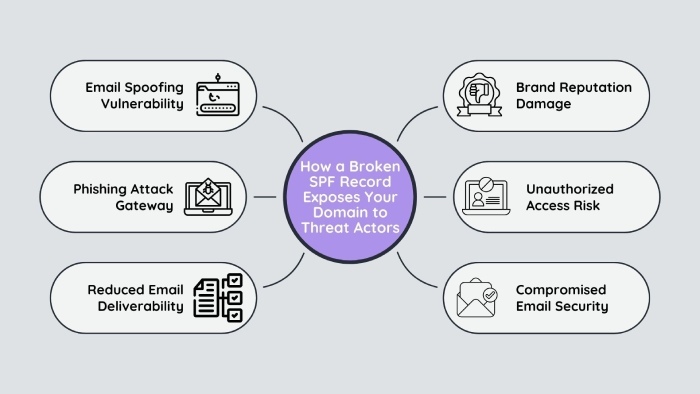Sender Policy Framework, or SPF, is one of the policies that keeps your email communications safe from malicious attempts of threat actors. But what happens if it gets broken? It can have serious implications, such as exposing your email systems to phishing and spoofing attacks. The email deliverability rate can also come down significantly. So, this is definitely a cause of concern for domain owners.
But what exactly does a broken SPF record mean? Is it really possible to fix this issue? This detailed guide is all you need to understand the complications of a broken SPF record and the step-by-step solutions to fix the issue.
Let’s get started!
What is a broken SPF record?
A broken SPF record means that it is either misconfigured, incomplete, or has exceeded certain technical limits. It clearly means that your SPF authentication system is not working properly and is not in a position to verify whether or not the emails sent from your domain are authentic. This may lead to security gaps and domain vulnerability.
How does a broken SPF affect your email ecosystem?
A broken SPF record is not something that you can ignore for very long. Here’s what happens if you don’t fix the broken SPF record as soon as possible:
Flawed email authentication
A broken SPF record hampers your email authentication system. It will no longer be possible to authenticate the emails that are sent out on behalf of your domain. A flawed SPF record enables malicious emails to creep into the system and pass through without being detected.
Also, even legitimate emails may get flagged because of the broken SPF record. It may end up landing in the recipients’ spam folders. Or worse- it can be rejected right away. If email communications of critical importance do not reach the customers, then this can further tarnish your business reputation, leading to financial loss in the long run.

Email communications are prone to phishing and spoofing attacks
A broken SPF record makes your domain an easy target for threat actors. It enables them to send malicious emails from your domain without getting detected. If cybercriminals misuse your domain for sending out spammy emails, then your domain may end up getting blocklisted by email providers. This will not only impact the deliverability of important email communications but also impact your business reputation and goodwill.
DMARC and SPF dependence
DMARC works in close coordination with SPF and DKIM results. Your email system passes the DMARC test when the SPF domain matches the ‘From’ address. This alignment gets hampered because of a broken SPF record. If your DMARC record has been set to reject or quarantine policy, then the emails that fail the SPF checks can be straightaway blocked or land in the spam folder.
Difficulty in monitoring and reporting
In case an SPF error takes place, the DMARC report reads as ‘permerror’ or ‘fail.’ This clearly means that the SPF check could not take place because of misconfigurations. If this keeps happening on a regular basis, it will ultimately affect your email performance and also lead to increased cases of false negatives or positives.
What leads to a broken SPF record?
Here are the multiple factors that can lead to a broken SPF record:
Multiple DNS lookups
Make sure that your SPF record does not exceed the maximum limit of 10 DNS lookups (as stated in the RFC specifications). The moment it exceeds the suggested limit, you get a failed SPF check that comes with a ‘Permerror.’ It means that even your legitimate emails may end up getting flagged.
Syntax errors
Common typographical or formatting mistakes can lead to a broken SPF record. Pay close attention to instances of:
- Misplaced modifiers such as +all, ~all, or -all.
- Missing colons or spaces.
- Wrong tags or unsupported mechanisms.
Misuse of wild cards
Wild cards should be used vigilantly, as misusing them may lead to security risks and a broken SPF record. For example, you must avoid adding a “*” mechanism. Otherwise, this will enable all domains to send out emails, leading to cybersecurity risks.
Broad mechanisms
Broad mechanisms such as +all enable every mail server to send emails from your domain. This leads to a direct clash with SPF policy, thereby leading to a broken SPF record.
Multiple SPF records
If there are multiple SPF records for a single domain, then it can lead to a conflict between mechanisms. DNS servers will simply get confused as to which SPF record they must refer to while getting your emails delivered.
DNS configuration problems
SPF records are dependent on the accuracy level of DNS configuration. If there is any issue with the DNS hosting, then this will easily impact the functionality of the SPF records. Some of the most common issues include incomplete propagation across DNS servers, deleted SPF records, syntax errors, and misconfigured DNS zones. If any of these errors occur, the recipient email servers will be prevented from accessing the SPF record. Ultimately, this will lead to authentication failure.
How can you fix a broken SPF record?
Here’s how to fix a broken SPF record to ensure smooth and seamless email communications:
For syntax error
Running your SPF record through an online SPF lookup tool before publishing the same can do the needful and let you know if there are any syntax errors.
For multiple DNS lookups
Regular auditing of third-party services can be helpful. Besides, consolidating IP addresses to minimize DNS lookups also helps. Using our automatic SPF flattening tool can ease the task further.
For multiple SPF records
Analyze your DNS settings to find out all the SPF records that are associated with your domain. Now combine all the valid mechanisms into one SPF record. Also, be extra careful so that the SPF record does not exceed the maximum limit of 10 lookups.
For incorrect usage of wild cards
It is better to stick to only defined mechanisms and IPS and avoid any kind of unnecessary wildcards.
For DNS misconfigurations
Start with closely monitoring the DNS changes. Using a DNS management tool for validating the accuracy of SPF records can also be of great help. DNS query tools can also ensure smooth and seamless propagation.
For broad mechanisms
Opt for strict validation by ending your SPF record with either ~all or -all. The former stands for soft fail, encouraging tests and adjustments. The latter stands for hard fail, which blocks unauthorized messages completely.
Final thoughts
A broken SPF record can make your domain vulnerable to malicious attempts and also impact overall email deliverability. It is, therefore, important to detect a broken SPF record and fix it immediately.
If you need any assistance getting your broken SPF record fixed, reach out to us.




